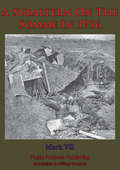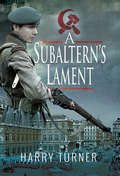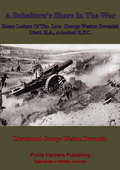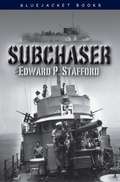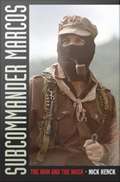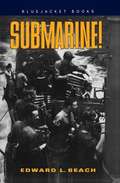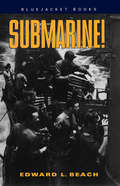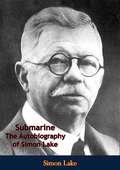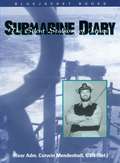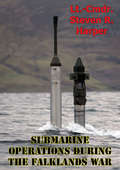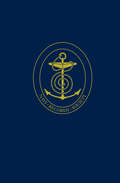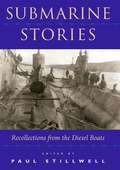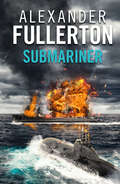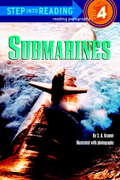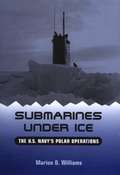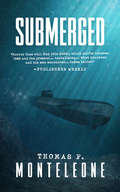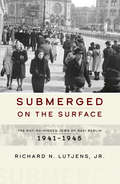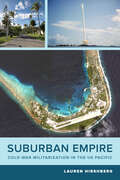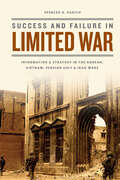- Table View
- List View
The Subaltern Officer. — A Narrative
by Captain George WoodThis ebook is purpose built and is proof-read and re-type set from the original to provide an outstanding experience of reflowing text for an ebook reader. George Foot started his military career in the Peninsula as a Lieutenant in the 82nd Foot, Prince of Wales's Volunteers, having being involved in the initial struggles around Lisbon at Roliça and Vimiero in 1808, before the general action at Talavera in 1809. Interestingly, he transferred to the 2nd Battalion of Detachments for the rest of the War before being seriously wounded at the battle of the Pyrenees. His narrative is enlivened with an eye for detail both in the battles he fought in and the towns and villages that he and his foot-sore comrades tramped through. Title - The Subaltern Officer. -- A Narrative Author -- Captain George Wood Text taken, whole and complete, from the edition published in 1825, London, by Septimus Prowett Original - xvi and 247 pages. Illustrations -- one illustrations.
A Subaltern On The Somme In 1916
by Mark Vii Pseud."The author of this memoir arrived on the Western Front to join 10th Bn. West Yorks in July 1916, shortly after the opening day of the Battle of the Somme in which his battalion had suffered the highest casualties of any battalion on that day - 710 of whom 306 were killed. His war ended in January 1917 when he was concussed by a shell exploding on the parapet in front of him.Regarded as one of the classics the book gives a vivid description of life in the trenches - the routine, the boredom , the mud and the horror. His war ended in January 1917 when he was concussed by a shell exploding on the parapet in front of him. Well recommended."-N&M Print Version
A Subaltern's Lament
by Harry TurnerVienna 1954, nine years after the end of World War II and the victorious allies occupy the whole of Austria.Newly commissioned national serviceman and Fulham boy, Rory Trenchard, joins his regiment, The Hambleshires, in Vienna at the very height of the Cold War. At nineteen he finds himself not only learning the tough art of soldiering alongside his platoon of Battle hardened Korean War veterans but is also exposed to the political machinations that exist between Britain and her Allies.Vienna in 1954 is a dangerous place and in addition to honing his skills as a warrior he is trusted to act as a go-between when a senior KGB officer plans to defect to the west. He also falls in and out of love with an American girl and faces the choice of either just completing two years national service, or becoming a regular officer.
A Subaltern’s Share In The War: Home Letters Of The Late George Weston Devenish Lieut. R.A., Attached R.F.C.
by Lieutenant George Weston DevenishLieutenant Devenish celebrated his twenty-first birthday, his last in peace-time, on the 25th of July 1914; he was by this point in his short life a soldier by profession and by choice. Having left Charterhouse with a taste for military ways after training in the O.T.C., he decided that his chosen profession should be spent in the Royal Artillery and entered into further training at Woolwich. By the time war begun in 1914 he was a fully-fledged officer. However, an indomitable spirit and a thirst for a more personal form of combat led him into the Royal Flying Corps. The R.F.C. would mourn his passing on the 6th of June 1917, after only a year of having him in their ranks. George Devenish's name is inscribed on the walls of the Arras Flying Services War Memorial, one of the many Allied fliers who lost their lives during the First World War fighting in the skies above the Western Front. A kindly, sensitive man, but filled with a great deal of passion and pride, his letters are almost always upbeat and despite the carnage around him during the war, he never changed his "sunny disposition".Author -- Lieutenant George Weston Devenish 1893-1917Text taken, whole and complete, from the edition published in London, Constable and Company Ltd., 1917.Original Page Count - xviii and 177 pages.
Subchaser
by Edward P. StaffordIn a wartime Navy of giant carriers and battleships, tiny wooden subchasers did not command much attention. Yet these 110-foot warships, manned mostly by inexperienced reservists, performed vital chores for the fleet everywhere there was action in World War II. They led landing craft right up to the assault beaches, protected them from fire, fought off air attacks, swept for mines, laid down smoke screens, and patrolled the sea for killer submarines. One such doughty little ship, subchaser 692, is the subject of this book.Told by 692's commanding officer Ed Stafford, then a twenty-four-year-old lieutenant (jg) on his first warship, the story follows the thirty-man crew as they scrapped their way through the war, including action during the July 1943 invasion of Sicily. Filled with humor, tension, poignancy, and moments of high drama, this volume leaves today's readers with a vivid image of life on a very small ship in a very big war.
Subcommander Marcos: The Man and the Mask
by Nick HenckSubcommander Marcos made his debut on the world stage on January 1, 1994, the day the North American Free Trade Agreement took effect. At dawn, from a town-hall balcony he announced that the Zapatista Army of National Liberation had seized several towns in the Mexican state of Chiapas in rebellion against the government; by sunset Marcos was on his way to becoming the most famous guerrilla leader since Che Guevara. Subsequently, through a succession of interviews, communiqus, and public spectacles, the Subcommander emerged as a charismatic spokesperson for the indigenous Zapatista uprising and a rallying figure in the international anti-globalization movement. In this, the first English-language biography of Subcommander Marcos, Nick Henck describes the thought, leadership, and personality of this charismatic rebel spokesperson. He traces Marcos's development from his provincial middle-class upbringing, through his academic career and immersion in the clandestine world of armed guerrillas, to his emergence as the iconic Subcommander. Henck reflects on what motivated an urbane university professor to reject a life of comfort in Mexico City in favor of one of hardship as a guerrilla in the mountainous jungles of Chiapas, and he examines how Marcos became a conduit through which impoverished indigenous Mexicans could communicate with the world. Henck fully explores both the rebel leader's renowned media savvy and his equally important flexibility of mind. He shows how Marcos's speeches and extensive writings demonstrate not only the Subcommander's erudition but also his rejection of Marxist dogmatism. Finally, Henck contextualizes Marcos, locating him firmly within the Latin American guerrilla tradition.
Submarine
by Edward L. Beach"Welcomed as the first book about American submarines in World War II to be written by a man who actually fought in them, this account of the war beneath the sea firmly established Edward L. Beach's reputation as a writer in the early 1950s. Given the survival rate of those in the silent service, it is a story many submariners did not live to tell. In fact, most of the crew of Beach's boat, the USS Trigger, were lost soon after he left for another assignment. A veteran of twelve war patrols, Beach authentically recaptures the moments of elation, desperation, and numbing fear that were part of the daily lives of these warriors as they hunted down the enemy in the Pacific." "Beach helped sink the Trigger's first ships and survived more than his share of exploding depth charges from avenging warships. This book weaves the Trigger's story with the equally thrilling tales of other battle-hardened submarines and the brave men who fought in them against the Japanese. Readers share in the destruction of five destroyers in four days and join in the deadliest game of all - stalking other submarines. They also come to understand the terror and uncertainty of being at the other end of the pursuit, and silently sweating out depth-charge poundings in a leaking boat. For an authentic account of what went on under the waves, this book remains one of the very best."--BOOK JACKET. Title Summary field provided by Blackwell North America, Inc. All Rights Reserved
Submarine!
by Edward L. BeachFor the World War II submariner, every day was a life-or-death trial: going to sea for months at a time; existing in dank, claustrophobic conditions; enduring long stretches of monotonous silence punctuated by adrenaline-spiked episodes of paralyzing fear and victorious elation. It was a duty few men could handle -- and even fewer would survive.This is the true story of those brave men who served and too often died under the ocean surface, written by a man who was there. Edward L. Beach masterfully weaves his gripping experiences aboard the USS Trigger with those of other boats fighting the war in the Pacific. Part action-packed combat chronicle, part testament to the courageous sacrifices made by those who never came back, this is a compelling eyewitness account of the war as few have seen it.
Submarine: The Autobiography of Simon Lake
by Simon LakePERHAPS no man in the past century has had as much to do with the shape of history as Simon Lake. That statement is intended as a query rather than as a statement of fact. It may be debatable, but it is also defendable.He is responsible for the modern submarine.The World War pivoted on him. Not on the Kaiser or Lloyd George or Hindenburg or Wilson or Ludendorff. He had nothing to do with the provocations or the settlements. He was an engineer almost unknown except on the coast of New Jersey and in a few capitals of Europe. His sympathies were not warmly engaged for either of the parties to the conflict. Not until the United States entered the war was he greatly stirred.Yet the pitch-pine boat he stitched and screwed and nailed together as a boy rattled a mighty empire. Great Britain’s crown as Queen of the Seas almost slipped off her imperial head. If she had gone down, France must have gone with her. The consequences of such a collapse are now incalculable. Today’s world may have been no worse than it is, but it must have been almost insanely different.
The Submarine: A History
by Thomas ParrishThe importance of submarines in the wars of the twentieth century.
Submarine Diary
by Corwin MendenhallA vividly detailed account of life aboard U.S. submarines in the Pacific during World War II.
Submarine Operations During The Falklands War
by Lieutenant Commander Steven R. HarperThis paper contains an analysis of submarine operations during the Falklands War. This was done to provide some insight on the importance of submarines in this conflict and to show the usefulness of submarines in any maritime conflict The submarine operations by both belligerents are looked at and compared over the duration of the conflict This is an unclassified study that was researched using published books, magazine articles, unpublished papers, unclassified government documents and interviews with officers involved in the conflict Reports done at a classified level were not used in the preparation of this paper. The submarine operations and methods of employment examined show the strength of submarines when properly used and the weakness when training is lacking or the submarine is used in the wrong manner. Also highlighted is the difficulty of antisubmarine efforts in a high ambient noise, shallow water environment Submarines can be a force multiplier to any navy when used properly and can frustrate an opponent by their presence or even their perceived presence. However, to get the full use of submarines they must be integrated fully into the military forces. With just a few boats in a navy, the submarines are wasted if they are operated independently. They must be fed intelligence or be intelligence platforms themselves to fully realize their potential. This point was not adhered to fully and thus submarines did not make the impact expected during the Falklands War.
The Submarine Service, 1900–1918 (Navy Records Society Publications #142)
by Nicholas LambertThe year 2001 marks the centenary of the Royal Navy's submarine service. In the aftermath of the 2016 celebrations of the Battle of Jutland centenary, it is worth considering how the First World War at sea changed. This volume opens with an examination of the background to the Board of Admiralty's decision in 1900 to buy submarines, bringing to light documents that go a long way toward dispelling the myth that Britain's pre-1914 naval leaders were opposed to the development of the submarine as a major weapon. Indeed, the documents show that senior naval officers and influential civilians in Whitehall believed that the advent of the submarine would revolutionize naval warfare in a way that would bolster the Royal Navy's position as the world's predominant naval power. This edited selection of documents illustrates not only the Admiralty's thinking on the employment of the submarine between 1900 and 1918, it also charts the technical development of British submarines, and explains issues such as why the pioneer submariners came to regard themselves as an élite group within the Royal Navy - and were allowed to become the 'silent service'.
Submarine Stories
by Paul L. StillwellCulled from many never-before-published narratives and oral histories conducted under the auspices of the U.S. Naval Institute, Submarine Stories presents nearly five dozen first-person accounts from men who were involved with gasoline- and diesel-powered submarines during the twentieth and twenty-first centuries. The story of these boats, their technological evolution and tactical value, is also the story of the men who went to sea in them. The accounts illustrate the human aspects of serving in diesel boats: the training, operations in peacetime and war, liberty exploits, humorous sidelights, and special feelings of bonding and camaraderie that grew among shipmates.Included here are some familiar names. Slade Cutter, who earned four Navy Crosses as a skipper in World War II, describes the process that made him a capable submariner. Dennis Wilkinson, first skipper of the nuclear-powered Nautilus in the 1950s, tells of being in the first missile-firing submarine in the 1940s.Robert McNitt recalls his experiences as executive officer to Medal of Honor skipper Gene Fluckey. Among the other submariners who present their personal memories are Jerry Beckley, contemplating the possibility of firing nuclear missiles during the 1962 Cuban crisis; Hosey Mays, describing what it was like to be a black man in a boat with a nearly all-white crew; Paul Foster, discussing the sinking a German U-boat in World War I; and Wayne Miller, explaining the enormous satisfaction he felt when he earned his silver dolphins.
Submariner
by Alexander FullertonAn epic Second World War adventure from the author of the Nicholas Everard naval thrillers, who &“recreates [life at sea] with authenticity and vigor&” (Historical Novel Society). As captain of the submarine Ursa, Lieutenant Mike Nicholson&’s mission is to disrupt the flow of war supplies to Rommel&’s Afrika Korps. Although Ursa is small, slow and often out-gunned, she succeeds, on her seventeenth Mediterranean cruise, in sinking a German tank-transporter. That triumph makes Mike top of the league—he has now sunk more tonnage than any of his contemporaries. Promotion to Lieutenant-Commander, at the age of twenty-eight, is on the cards. All he has to do is adhere to two rules: stay alive, and keep his nose clean . . . Submariner is a gripping Second World War naval thriller that will appeal to fans of Douglas Reeman and Jack Higgins. Praise for the writing of Alexander Fullerton &“His action passages are superb, and he never puts a period foot wrong.&” —The Observer &“You don&’t read a novel by Alexander Fullerton. You LIVE it.&” —South Wales Echo &“The research is unimpeachable and the scent of battle quite overpowering.&” —The Sunday Times
Submarines (Step into Reading)
by Sydelle KramerYoung readers are in for the most exciting trip of their lives as they venture into a nuclear submarine! While touring the vessel from bow to stern, they learn about the history and mechanics of subs, their military and scientific uses, and the incredible discomfort-and danger-of life onboard. Illustrated with photographs, this is easy-to-read, high-interest nonfiction at its most compelling!
Submarines under Ice: The U.S. Navy's Polar Operations
by Marion D. WilliamsThe author beautifully depicts the 1931 submarine expedition of Sir Hubert Wilkins to explore the Arctic Ocean. The book also shows the rapid advance of science and technology in submarines.
Submerged
by Thomas F. Monteleone&“An epic thriller about a secret Nazi submarine and its mission . . . a tasty combination of Ken Follett and Clive Cussler&” from the award-winning author (The Novel Pursuit). Cruising from the sub pens of Trondheim under the cover of darkness—undetected by the sonar scans of Allied enemies—Kapitaenleutnant Erich Heinz Bruckner leads the experimental submarine U-5001 in a last-ditch effort for Nazi victory. But their sinister 1945 voyage ends mysteriously: Bruckner and his crew vanish, along with their classified weapon of mass destruction. Seventy years later, ex-Navy diver Dexter Bucklin stumbles upon an unknown vessel in the depths of the Chesapeake Bay and is consumed with the need to discover its original, terrifying mission—inadvertently alerting a worldwide cabal that knows all about the U-5001 . . . and the keys it holds to even greater secrets. A thriller in the tradition of Ken Follett and Robert Ludlum, Submerged follows both Bruckner and Bucklin in a narrative that spans generations of adventure and horror—Lovecraftian tales at their most strange. As these men&’s lives converge, a third element surfaces, influencing the Kapitaenleutnant and the ex-Navy diver to make increasingly desperate decisions, ones that will shape the future of civilization. Thomas F. Monteleone expertly blends history, fact, and fiction with a subtle dose of the supernatural in this Lovecraftian page-turner. Praise for Thomas F. Monteleone &“Monteleone has a dark imagination, a wicked pen, and the rare ability to convey an evil chill with words.&” —Dean Koontz, New York Times–bestselling author &“Tom&’s an expert storyteller.&” —F. Paul Wilson, author of The Keep and Deep as the Marrow &“A vastly entertaining novel of horror and suspense [that poses] difficult questions about the nature of man, God and the devil.&” —Los Angeles Daily News
Submerged on the Surface: The Not-So-Hidden Jews of Nazi Berlin, 1941–1945
by Richard LutjensBetween 1941 and 1945, thousands of German Jews, in fear for their lives, made the choice to flee their impending deportations and live submerged in the shadows of the Nazi capital. Drawing on a wealth of archival evidence and interviews with survivors, this book reconstructs the daily lives of Jews who stayed in Berlin during the war years. Contrary to the received wisdom that “hidden” Jews stayed in attics and cellars and had minimal contact with the outside world, the author reveals a cohort of remarkable individuals who were constantly on the move and actively fought to ensure their own survival.
SubOrbital 7
by John ShirleyA routine rescue mission leaves a team of US soldiers, rescued hostages and a prisoner trapped above Earth in a suborbital craft, in this cinematic action-packed near-future thriller, perfect for fans of Tom Clancy and Jack Carr.Lieutenant Art Burkett is called up to take part in a rescue mission. Three scientists have been kidnapped by the terrorist group Thieves in Law. The rescue is swift. Art and his team return to military craft SubOrbital 7, intending to return to safety with hostages rescued and prisoners in tow. But Thieves in Law are not the only people looking for them. Art and his team must fight an ever-growing threat before time runs out for them, and possibly for the rest of the world.
Substance Use Disorders In The U.S. Armed Forces
by Committee on Prevention Diagnosis Treatment Management of Substance Use Disorders in the U.S. Armed ForcesProblems stemming from the misuse and abuse of alcohol and other drugs are by no means a new phenomenon, although the face of the issues has changed in recent years. National trends indicate substantial increases in the abuse of prescription medications. These increases are particularly prominent within the military, a population that also continues to experience long-standing issues with alcohol abuse. The problem of substance abuse within the military has come under new scrutiny in the context of the two concurrent wars in which the United States has been engaged during the past decade--in Afghanistan (Operation Enduring Freedom) and Iraq (Operation Iraqi Freedom and Operation New Dawn). Increasing rates of alcohol and other drug misuse adversely affect military readiness, family readiness, and safety, thereby posing a significant public health problem for the Department of Defense (DoD). To better understand this problem, DoD requested that the Institute of Medicine (IOM) assess the adequacy of current protocols in place across DoD and the different branches of the military pertaining to the prevention, screening, diagnosis, and treatment of substance use disorders (SUDs). Substance Use Disorders in the U. S. Armed Forces reviews the IOM's task of assessing access to SUD care for service members, members of the National Guard and Reserves, and military dependents, as well as the education and credentialing of SUD care providers, and offers specific recommendations to DoD on where and how improvements in these areas could be made.
Subsunk
by W. O. ShelfordFrom the book: The dread signal cuts through the ether like a knife. No code clerk need spell out its meaning it is the signal of disaster. Somewhere a sub is down, men are trapped far below the ocean's surface, time is running out... This is an absorbing drama of submarine escape. Crammed with stories of horror and despair, of incredible fortitude and courage, it reflects the supreme dedication of the men who brave the hazards of the silent service.
Suburban Empire: Cold War Militarization in the US Pacific (American Crossroads #64)
by Lauren HirshbergSuburban Empire takes readers to the US missile base at Kwajalein Atoll in the Marshall Islands, at the matrix of postwar US imperial expansion, the Cold War nuclear arms race, and the tide of anti-colonial struggles rippling across the world. Hirshberg shows that the displacement of indigenous Marshallese within Kwajalein Atoll mirrors the segregation and spatial politics of the mainland US as local and global iterations of US empire took hold. Tracing how Marshall Islanders navigated US military control over their lands, Suburban Empire reveals that Cold War–era suburbanization was perfectly congruent with US colonization, military testing, and nuclear fallout. The structures of suburban segregation cloaked the destructive history of control and militarism under a veil of small-town innocence.
Success and Failure in Limited War: Information and Strategy in the Korean, Vietnam, Persian Gulf, and Iraq Wars
by Spencer D. BakichCommon and destructive, limited wars are significant international events that pose a number of challenges to the states involved beyond simple victory or defeat. Chief among these challenges is the risk of escalationOCobe it in the scale, scope, cost, or duration of the conflict. In this book, Spencer D. Bakich investigates a crucial and heretofore ignored factor in determining the nature and direction of limited war: information institutions. Traditional assessments of wartime strategy focus on the relationship between the military and civilians, but Bakich argues that we must take into account the information flow patterns among top policy makers and "all" national security organizations. By examining the fate of American military and diplomatic strategy in four limited wars, Bakich demonstrates how not only the availability and quality of information, but also the ways in which information is gathered, managed, analyzed, and used, shape a stateOCOs ability to wield power effectively in dynamic and complex international systems. Utilizing a range of primary and secondary source materials, "Success and Failure in Limited War" makes a timely case for the power of information in war, with crucial implications for international relations theory and statecraft. "
Successful Strategies
by Williamson Murray Richard Hart SinnreichSuccessful Strategies is a fascinating new study of the key factors that have contributed to the development and execution of successful strategies throughout history. With a team of leading historians, Williamson Murray and Richard Hart Sinnreich examine how, and to what effect states, individuals and military organizations have found a solution to complex and seemingly insoluble strategic problems to reach success. Bringing together grand, political and military strategy, the book features thirteen essays which each explores a unique case or aspect of strategy. The focus ranges from individuals such as Themistocles, Bismarck and Roosevelt to organizations and bureaucratic responses. Whether discussing grand strategy in peacetime or that of war or politics, these case studies are unified by their common goal of identifying in each case the key factors that contributed to success as well as providing insights essential to any understanding of the strategic challenges of the future.

